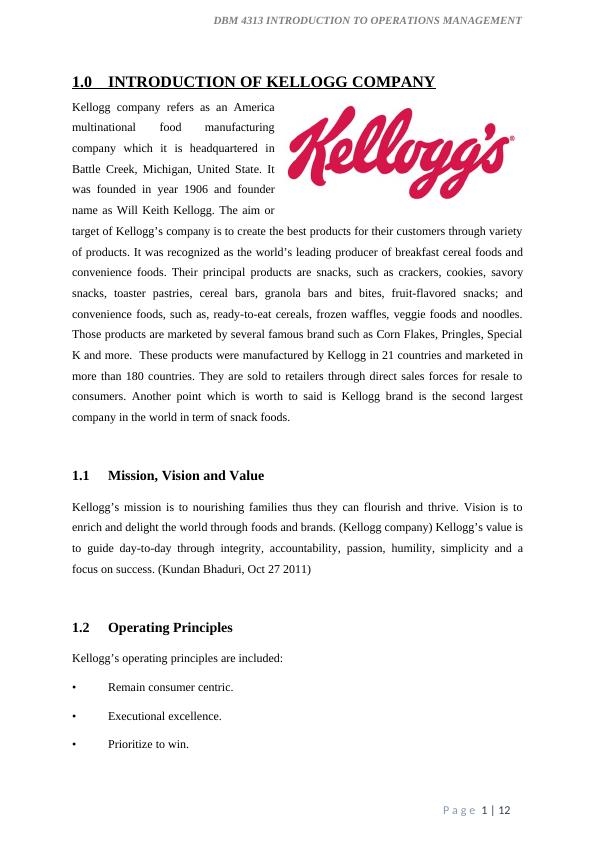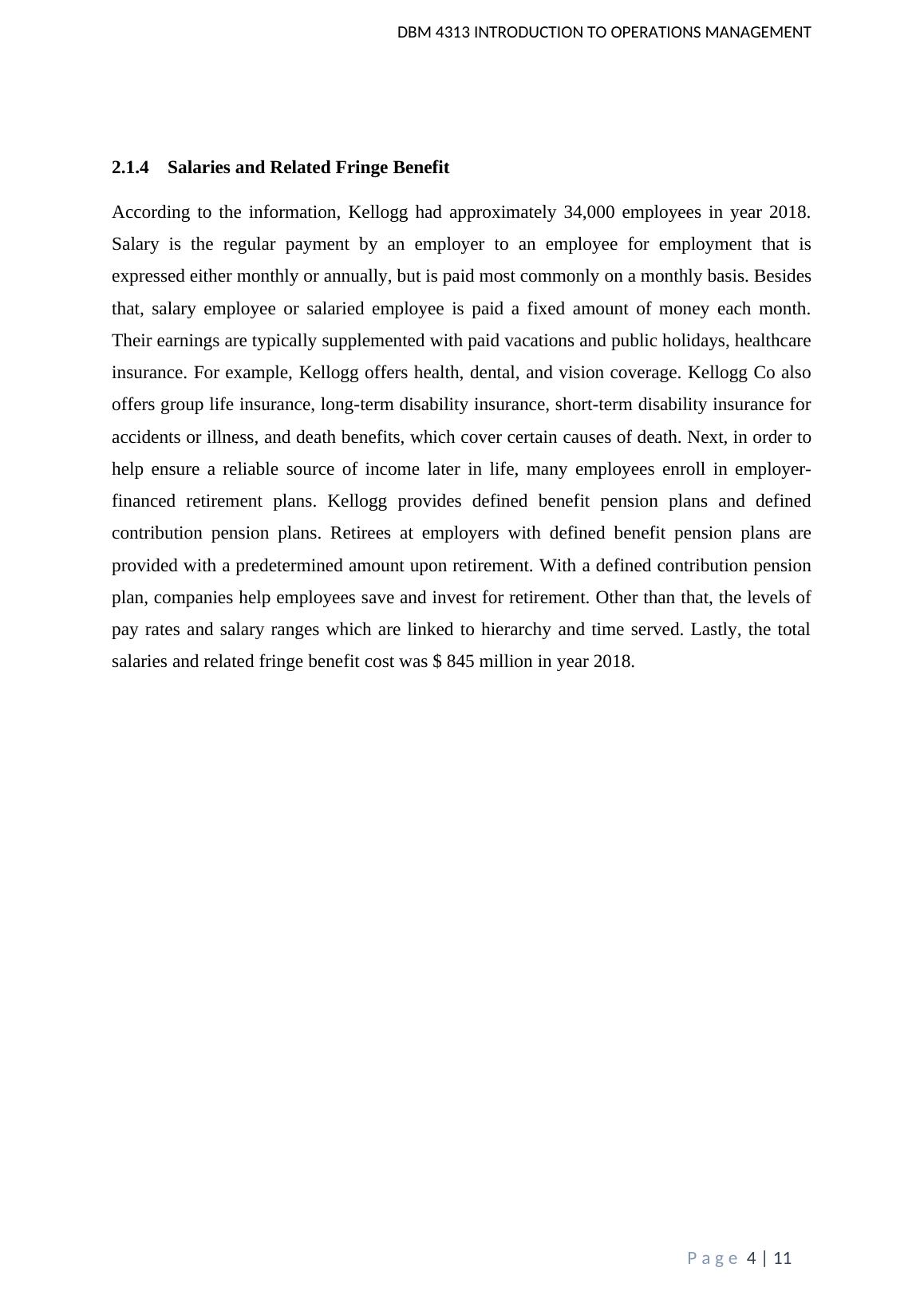DBM 4313 introduction to operations management PDF
Added on 2021-10-09
12 Pages2692 Words32 Views
DBM 4313 INTRODUCTION TO OPERATIONS MANAGEMENT
1.0 INTRODUCTION OF KELLOGG COMPANY
Kellogg company refers as an America
multinational food manufacturing
company which it is headquartered in
Battle Creek, Michigan, United State. It
was founded in year 1906 and founder
name as Will Keith Kellogg. The aim or
target of Kellogg’s company is to create the best products for their customers through variety
of products. It was recognized as the world’s leading producer of breakfast cereal foods and
convenience foods. Their principal products are snacks, such as crackers, cookies, savory
snacks, toaster pastries, cereal bars, granola bars and bites, fruit-flavored snacks; and
convenience foods, such as, ready-to-eat cereals, frozen waffles, veggie foods and noodles.
Those products are marketed by several famous brand such as Corn Flakes, Pringles, Special
K and more. These products were manufactured by Kellogg in 21 countries and marketed in
more than 180 countries. They are sold to retailers through direct sales forces for resale to
consumers. Another point which is worth to said is Kellogg brand is the second largest
company in the world in term of snack foods.
1.1 Mission, Vision and Value
Kellogg’s mission is to nourishing families thus they can flourish and thrive. Vision is to
enrich and delight the world through foods and brands. (Kellogg company) Kellogg’s value is
to guide day-to-day through integrity, accountability, passion, humility, simplicity and a
focus on success. (Kundan Bhaduri, Oct 27 2011)
1.2 Operating Principles
Kellogg’s operating principles are included:
• Remain consumer centric.
• Executional excellence.
• Prioritize to win.
P a g e 1 | 12
1.0 INTRODUCTION OF KELLOGG COMPANY
Kellogg company refers as an America
multinational food manufacturing
company which it is headquartered in
Battle Creek, Michigan, United State. It
was founded in year 1906 and founder
name as Will Keith Kellogg. The aim or
target of Kellogg’s company is to create the best products for their customers through variety
of products. It was recognized as the world’s leading producer of breakfast cereal foods and
convenience foods. Their principal products are snacks, such as crackers, cookies, savory
snacks, toaster pastries, cereal bars, granola bars and bites, fruit-flavored snacks; and
convenience foods, such as, ready-to-eat cereals, frozen waffles, veggie foods and noodles.
Those products are marketed by several famous brand such as Corn Flakes, Pringles, Special
K and more. These products were manufactured by Kellogg in 21 countries and marketed in
more than 180 countries. They are sold to retailers through direct sales forces for resale to
consumers. Another point which is worth to said is Kellogg brand is the second largest
company in the world in term of snack foods.
1.1 Mission, Vision and Value
Kellogg’s mission is to nourishing families thus they can flourish and thrive. Vision is to
enrich and delight the world through foods and brands. (Kellogg company) Kellogg’s value is
to guide day-to-day through integrity, accountability, passion, humility, simplicity and a
focus on success. (Kundan Bhaduri, Oct 27 2011)
1.2 Operating Principles
Kellogg’s operating principles are included:
• Remain consumer centric.
• Executional excellence.
• Prioritize to win.
P a g e 1 | 12

DBM 4313 INTRODUCTION TO OPERATIONS MANAGEMENT
• Continuous efficiency improvement.
2.0 KELLOGG MAIN COST COMPONENTS
In a business, cost expresses the amount of money that is spent
on the production or creation of a good or service. Cost does
not include a mark-up for profit. From a seller’s point of view,
cost is the amount of money spent to produce a product or
good. In accounting, the term cost refers to the monetary value
of expenditures for services, supplies, raw materials, labor,
products, equipment, etc. Lastly, each expenses cost will be record in financial annual report.
Kallogg had record all their operating cost, income statement/profit and loss statement and
cash flow statement/cash budget statement in the annual report 2018. Below were those main
cost components of Kellogg.
2.1 Diagram Of The Main Cost Components of Kellogg
36%
25%
16%
23%
Main Cost Components In Year 2018 ($ million)
Cost of Goods Sold (COGS) Selling,General and Administrative Expense (SAG)
Capital Expenditure Salaries And Related Fringe Benefit
P a g e 2 | 12
• Continuous efficiency improvement.
2.0 KELLOGG MAIN COST COMPONENTS
In a business, cost expresses the amount of money that is spent
on the production or creation of a good or service. Cost does
not include a mark-up for profit. From a seller’s point of view,
cost is the amount of money spent to produce a product or
good. In accounting, the term cost refers to the monetary value
of expenditures for services, supplies, raw materials, labor,
products, equipment, etc. Lastly, each expenses cost will be record in financial annual report.
Kallogg had record all their operating cost, income statement/profit and loss statement and
cash flow statement/cash budget statement in the annual report 2018. Below were those main
cost components of Kellogg.
2.1 Diagram Of The Main Cost Components of Kellogg
36%
25%
16%
23%
Main Cost Components In Year 2018 ($ million)
Cost of Goods Sold (COGS) Selling,General and Administrative Expense (SAG)
Capital Expenditure Salaries And Related Fringe Benefit
P a g e 2 | 12

DBM 4313 INTRODUCTION TO OPERATIONS MANAGEMENT
P a g e 3 | 12
P a g e 3 | 12

DBM 4313 INTRODUCTION TO OPERATIONS MANAGEMENT
2.1.1 Cost of Goods Sold (COSG)
The cost of goods sold (COGS) of Kellogg is refers to the direct costs attributable to the
production of the goods sold in a company. It is the accumulated total of all costs used to
create a product or service, which has been sold. This amount includes the cost of the
materials used in creating the good along with the direct labor costs used to produce the good.
It excludes indirect expenses, such as distribution costs and sales force costs. Cost of goods
sold is also referred to as "cost of sales." According to the annual report, the total COGS in
year 2018 was $ 1,330 million.
2.1.2 Selling, General and Administrative Expenses (SAG)
Selling, general and administrative expenses are known commonly as SAG expenses. It
defined as the costs incurred to sell goods and support operations. SAG costs are including
the salaries and commissions paid to the marketing, research and development, advertising
and sales team. It also includes the expenses they incur to perform their duties. For example,
a sales representative may be required to travel and meet with prospective clients. Because
the trip is related to sales, the rep's salary and his travel expenses both are included on the
income statement as SAG costs. Expenses incurred to advertise a product in a local
newspaper or on a billboard are also SAG expenses. The SAG cost was $ 906 million in year
2018.
2.1.3 Capital Expenditures
The capital expenditure refers to the expenditure of funds for an asset that is expected to
provide utility to a business for more than one reporting period. Capital expenditures included
buildings (including subsequent costs that extend the useful life of a building), computer
equipment, office equipment, furniture and fixtures (including the cost of furniture that is
aggregated and treated as a single unit, such as a group of desks), intangible assets (such as a
purchased taxi license or a patent), land (including the cost of upgrading the land, such as the
cost of an irrigation system or a parking lot), machinery (including the costs required to bring
the equipment to its intended location and for its intended use), software for company
operation purpose and vehicles for company fetching or delivery purpose. Based on the
information given, the total capital expenditures cost was $ 578 million in year 2018.
P a g e 4 | 12
2.1.1 Cost of Goods Sold (COSG)
The cost of goods sold (COGS) of Kellogg is refers to the direct costs attributable to the
production of the goods sold in a company. It is the accumulated total of all costs used to
create a product or service, which has been sold. This amount includes the cost of the
materials used in creating the good along with the direct labor costs used to produce the good.
It excludes indirect expenses, such as distribution costs and sales force costs. Cost of goods
sold is also referred to as "cost of sales." According to the annual report, the total COGS in
year 2018 was $ 1,330 million.
2.1.2 Selling, General and Administrative Expenses (SAG)
Selling, general and administrative expenses are known commonly as SAG expenses. It
defined as the costs incurred to sell goods and support operations. SAG costs are including
the salaries and commissions paid to the marketing, research and development, advertising
and sales team. It also includes the expenses they incur to perform their duties. For example,
a sales representative may be required to travel and meet with prospective clients. Because
the trip is related to sales, the rep's salary and his travel expenses both are included on the
income statement as SAG costs. Expenses incurred to advertise a product in a local
newspaper or on a billboard are also SAG expenses. The SAG cost was $ 906 million in year
2018.
2.1.3 Capital Expenditures
The capital expenditure refers to the expenditure of funds for an asset that is expected to
provide utility to a business for more than one reporting period. Capital expenditures included
buildings (including subsequent costs that extend the useful life of a building), computer
equipment, office equipment, furniture and fixtures (including the cost of furniture that is
aggregated and treated as a single unit, such as a group of desks), intangible assets (such as a
purchased taxi license or a patent), land (including the cost of upgrading the land, such as the
cost of an irrigation system or a parking lot), machinery (including the costs required to bring
the equipment to its intended location and for its intended use), software for company
operation purpose and vehicles for company fetching or delivery purpose. Based on the
information given, the total capital expenditures cost was $ 578 million in year 2018.
P a g e 4 | 12

End of preview
Want to access all the pages? Upload your documents or become a member.
Related Documents
SWOT Analysis of Kellogg Companylg...
|10
|2954
|439
Financial Statement Analysis of Kellogg Companylg...
|10
|3146
|51
Kellogg-Sustainable Marketing Assignmentlg...
|19
|3652
|465
Financial Performance Report Kelloglg...
|14
|3227
|337
Introducing the Modern Workplacelg...
|24
|1274
|42
Sales and Merchandising in Kellogg : Reportlg...
|27
|8730
|336
